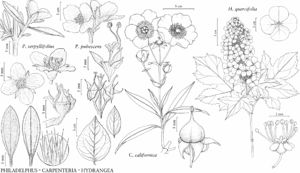Hydrangea
Sp. Pl. 1: 397. 1753.
| Taxon | Illustrator ⠉ | |
|---|---|---|
 | Philadelphus pubescens Carpenteria californica Hydrangea quercifolia Philadelphus serpyllifolius | John Myers Yevonn Wilson-Ramsey Yevonn Wilson-Ramsey John Myers |
Shrubs or trees. Stems erect, ascending, or spreading. Bark exfoliating in grayish, brown, or reddish-brown sheets. Branches erect, ascending, or spreading, sometimes arching; twigs with simple or branched trichomes. Leaves deciduous, opposite or 3-whorled; petiole present; blade ovate, elliptic-ovate, elliptic, or suborbiculate, sometimes lobed, herbaceous, margins serrate to serrulate, plane; venation pinnate. Inflorescences terminal, cymose-panicles, 100–1000-flowered; peduncle present. Pedicels present. Flowers bisexual or marginal ones often sterile (these with a petaloid, salverform calyx); perianth and androecium epigynous or perigynous; hypanthium campanulate or hemispheric, completely adnate to ovary, weakly or strongly 7–10 (–11) -ribbed in fruit; sepals persistent, 5, spreading or reflexed, deltate to shallowly triangular, usually glabrous, rarely abaxially sparsely hairy; petals 5, valvate, spreading or reflexed, white to yellowish white, ovatelanceolate, elliptic, oblong, spatulate, or narrowly ovate to ovate, base sessile, surfaces glabrous; stamens 10; filaments distinct, terete or flattened proximally, gradually or abruptly tapered from base to apex, apex not 2-lobed; anthers depressed-ovoid or transversely oblong; pistil 2–4-carpellate, ovary completely inferior or nearly so, or 1/2 inferior, 2–4-locular; placentation axile proximally, parietal distally; styles persistent, 2–4, distinct or connate to middle or distally. Capsules hemispheric, suburceolate, or oblong-ovoid, coriaceous, dehiscence interstylar, creating elliptic to circular pore at base of styles. Seeds 10–40 per locule, light-brown to dark-brown, fusiform or ellipsoid. x = 18.
Distribution
United States, Mexico, Central America, w South America, e Asia
Discussion
Species ca. 29 (5 in the flora).
Hydrangea enjoys considerable esteem as an ornamental shrub, especially for its prominent sterile flowers. North American species have been cultivated in Europe since before the mid 1700s (W. L. Stern 1978). Besides the species treated here, popular ornamentals in North America are H. anomala D. Don, H. aspera D. Don, H. heteromalla D. Don, H. involucrata Siebold, H. macrophylla (Thunberg) Seringe, and H. serrata (Thunberg) Seringe. Among these, H. macrophylla may be the most widely grown; M. A. Dirr (2004) listed nearly 170 cultivars of this species. Surprisingly, it has not escaped from cultivation.
Tubercles, comprising crystals of calcium carbonate, often are visible on leaf trichomes (G. W. Burkett 1932). They are observed most easily at magnifications greater than 30\x, and some taxonomic utility has been ascribed to their presence and abundance.
Toxic and medicinal properties are attributed to some native and cultivated species of Hydrangea (J. M. Kingsbury 1964; W. L. Stern 1978; D. E. Moerman 1998; G. E. Burrows and R. J. Tyrl 2001). These possibly are related to various alkaloids present in roots and leaves of some species.
Y. De Smet et al. (2015) found Hydrangea to be polyphyletic and promoted adoption of a broader, monophyletic concept of Hydrangea that includes all eight genera in tribe Hydrangeeae. Both North American genera in the tribe, Decumaria and Hydrangea, are circumscribed here in their traditional senses.
Selected References
Lower Taxa
Key
| 1 | Leaf blades (3–)5(–7)-lobed, margins coarsely serrate; inflorescences ovoid to conic. | Hydrangea quercifolia |
| 1 | Leaf blades unlobed, margins dentate, serrate, or serrulate; inflorescences dome-shaped to hemispheric or conic to ovoid. | > 2 |
| 2 | Ovaries 1/2 inferior; inflorescences usually conic, sometimes ovoid. | Hydrangea paniculata |
| 2 | Ovaries completely inferior or nearly so; inflorescences dome-shaped to hemispheric. | > 3 |
| 3 | Leaf blade abaxial surfaces white or grayish, densely tomentose, trichomes at 40× either smooth, 1–3 mm, or sparsely tuberculate, 0.3–1 mm. | Hydrangea radiata |
| 3 | Leaf blade abaxial surfaces green, glabrous or glabrate, or grayish, uniformly velutinous, pilose, or tomentose, trichomes at 40× conspicuously tuberculate, 0.3–1 mm. | > 4 |
| 4 | Leaf blade abaxial surfaces green, glabrous or glabrate, or sparsely hirsute along midveins and sometimes along lateral veins. | Hydrangea arborescens |
| 4 | Leaf blade abaxial surfaces grayish, uniformly velutinous, pilose, or tomentose. | Hydrangea cinerea |
"connate" is not a number. "distinct" is not a number.